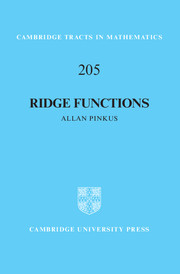Book contents
- Frontmatter
- Contents
- Preface
- Glossary of Selected Symbols
- 1 Introduction
- 2 Smoothness
- 3 Uniqueness
- 4 Identifying Functions and Directions
- 5 Polynomial Ridge Functions
- 6 Density and Representation
- 7 Closure
- 8 Existence and Characterization of Best Approximations
- 9 Approximation Algorithms
- 10 Integral Representations
- 11 Interpolation at Points
- 12 Interpolation on Lines
- References
- Supplemental References
- Author Index
- Subject Index
8 - Existence and Characterization of Best Approximations
Published online by Cambridge University Press: 05 August 2015
- Frontmatter
- Contents
- Preface
- Glossary of Selected Symbols
- 1 Introduction
- 2 Smoothness
- 3 Uniqueness
- 4 Identifying Functions and Directions
- 5 Polynomial Ridge Functions
- 6 Density and Representation
- 7 Closure
- 8 Existence and Characterization of Best Approximations
- 9 Approximation Algorithms
- 10 Integral Representations
- 11 Interpolation at Points
- 12 Interpolation on Lines
- References
- Supplemental References
- Author Index
- Subject Index
Summary
In this chapter we study the question of the existence and characterization of best approximations from the space of linear combinations of ridge functions with a finite number of directions. That is, from the space given by the restriction of
to a domain K ⊆ Rn, and to where all the fi(Aix) lie in an appropriate normed linear space. These normed linear spaces will be X = Lp(K), p ∊ (1, ∞), and X = C(K).
Section 8.1 contains some general results regarding existence and characterization of a best approximation from a linear subspace. In Section 8.2 we consider the space Lp(K) for p ∊ (1, ∞), and highlight the case p = 2, while Section 8.3 contains a few simple examples of that theory. In Section 8.4 we look at C(K) where, unfortunately, we only have results when approximating from linear combination of ridge functions with two directions. Very little seems to be known about these questions in other normed linear spaces.
General Results
In approximation theory, a set M in a normed linear space X is said to be an existence set (sometimes called a proximinal set) if to each G ∊ X there exists at least one best approximation to G from M. That is, to each G ∊ X there exists an F* ∊ M satisfying
A necessary condition for M to be an existence set is that it be closed. But closure, in general, is insufficient to guarantee existence.
Closed convex subsets of finite-dimensional subspaces are existence sets. But linear combinations of ridge functions of the form (8.1) are not finite-dimensional, unless K is very restricted. However, closed convex sets of a uniformly convex Banach space are existence sets.
- Type
- Chapter
- Information
- Ridge Functions , pp. 90 - 104Publisher: Cambridge University PressPrint publication year: 2015



